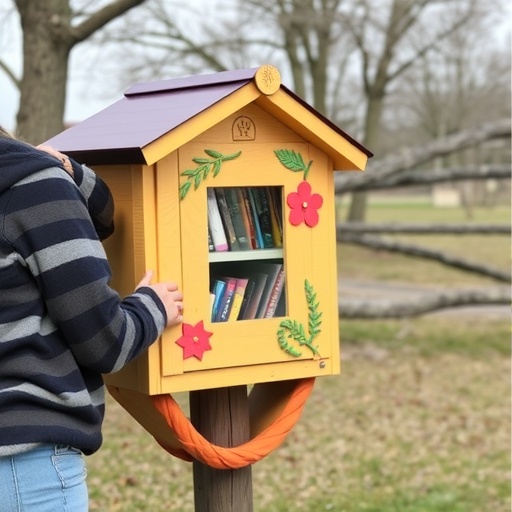In the past two decades, mental health disorders and suicide rates have experienced a persistent and alarming upward trend across the United States, with the most pronounced increases occurring in rural communities. These regions often grapple with unique challenges such as limited access to specialized care, stigma surrounding mental illness, and fewer available resources. In response to these deepening healthcare disparities, innovative, low-cost interventions designed to extend mental health support beyond traditional clinical environments have become critically important. One such novel approach has emerged from a rural primary care clinic in Minnesota, where physicians have introduced a “little free library” stocked with curated mental health and wellness books, offering patients and community members accessible, patient-centered educational materials.
The concept of the little free library is simple yet ingenious: a small, publicly accessible box situated conspicuously near the clinic’s entrance, containing 10 to 15 books covering a spectrum of mental health topics including anxiety, depression, post-traumatic stress disorder (PTSD), and other related conditions. This physical repository is complemented by a flyer bearing a QR code, which directs users to an online community-led webpage that provides additional mental health resources, effectively bridging the gap between tangible and digital information access. By embedding mental health resources in everyday settings outside formal therapy sessions or hospital wards, this initiative challenges the traditional healthcare delivery model and expands the reach of critical educational materials.
The choice of literature within the library is carefully curated to resonate with adults who might be experiencing mental health challenges but are hesitant or unable to seek formal treatment. The books include self-help guides, evidence-based psychoeducational texts, and narratives aimed at destigmatizing mental disorders. This diversity ensures that individuals across the spectrum—from those seeking basic coping strategies to patients interested in understanding their diagnoses more thoroughly—can find value. Moreover, the physical presence of the library acts as a passive invitation for clinic visitors to engage with their mental well-being, normalizing conversations about mental health within a community context.
.adsslot_TSkr63nZsy{width:728px !important;height:90px !important;}
@media(max-width:1199px){ .adsslot_TSkr63nZsy{width:468px !important;height:60px !important;}
}
@media(max-width:767px){ .adsslot_TSkr63nZsy{width:320px !important;height:50px !important;}
}
ADVERTISEMENT
In a deliberate effort to evaluate the effectiveness and reach of this intervention, patients who take books from the little free library are encouraged to complete a brief survey. This survey collects data on demographics, referral sources, and the perceived usefulness of the materials, which provides the research team with preliminary insights into who is utilizing the resource and how it impacts their understanding or management of mental health concerns. Although the evaluation is ongoing, preliminary impressions suggest the intervention’s potential to foster patient empowerment and enhance mental health literacy among rural populations where formal mental health services can be sparse.
This initiative embodies an intersection of public health innovation and community engagement, leveraging existing clinic foot traffic to offer low-barrier, stigma-reducing tools. Mental health services in rural areas are frequently hampered by workforce shortages, long travel distances, and cultural factors dissuading formal care-seeking behavior. By embedding mental health resources within primary care—a setting often viewed as less stigmatizing—the little free library project may lower psychological and logistical barriers simultaneously. This interdisciplinary approach aligns with emerging models that integrate primary care and behavioral health, emphasizing prevention and early intervention.
Additionally, the inclusion of a QR code flyer linking to an online resource hub represents a thoughtful integration of technology with traditional literacy tools. Digital health platforms can provide dynamic, regularly updated content, support community interaction, and potentially allow for deeper engagement such as teletherapy referrals or online support groups. The hybridization of physical and digital resources reflects an understanding that effective health communication must meet patients where they are, both physically and in terms of technology use.
From a public health perspective, this model offers scalability and replicability. Little free libraries can be deployed in diverse settings—other rural clinics, community centers, libraries, or even workplaces—at relatively low cost and with minimal infrastructure demands. The framework fosters community involvement by encouraging participation in resource curation and evaluation, thereby cultivating a sense of ownership and sustainability. Such grassroots models are increasingly valued for addressing social determinants of health by situating interventions within the lived realities of target populations.
The pilot project, spearheaded by physicians Marijo Botten, DO, and Erin Westfall, DO, from the Mayo Clinic Family Medicine Residency in Mankato, Minnesota, has underscored the importance of local context when developing mental health interventions. The rural Midwest, with its unique demographic and cultural characteristics, necessitates tailored approaches that align with community values and needs. The success of this initiative may prompt further research into how integrating mental health education within everyday community spaces influences patterns of help-seeking, treatment adherence, and overall wellbeing.
Critically, this approach situates mental health resources within a continuum of care that prioritizes accessibility and destigmatization. It acknowledges that medication or psychotherapy alone are insufficient to address the expanding mental health crisis, advocating for complementary educational tools that can enhance patient engagement and self-management. As mental health disorders are multifactorial and deeply embedded within social, economic, and cultural contexts, multifaceted strategies like this can contribute meaningfully to comprehensive care frameworks.
While the data on effectiveness is still being collected, early feedback from participants indicates that many find the books helpful for understanding their symptoms and coping strategies, while the community webpage offers valuable supplementary information. This suggests that blending self-directed learning with access to community resources has tangible benefits. Moreover, the low-cost nature of the program makes it a particularly attractive option for resource-strapped rural clinics seeking to augment their mental health service capacity.
As mental health continues to be a pressing public health priority, especially in underserved rural areas, creative solutions such as the little free library present promising avenues for intervention. They embody patient-centeredness not only by providing educational content but also by respecting autonomy and privacy, allowing individuals to approach mental health on their own terms. This aligns with modern health communication principles that emphasize empowering individuals through knowledge while reducing stigma through normalization and accessibility.
Subject of Research: Mental health access interventions in rural primary care settings
Article Title: Using a Little Free Library to Improve Access to Mental Health and Wellness Resources at a Primary Care Clinic
News Publication Date: 27-May-2025
Web References:
https://www.annfammed.org/sites/default/files/additional_assets/PDF%20Documents/PDF/TEMPORARY_LINK_EXPIRES_MAY_27_2025/botten.pdf
https://www.annfammed.org/content/23/3/273
Keywords: Family medicine, Mental health, Rural populations
Tags: accessible mental health resourcescommunity mental health supporteducational resources for mental healthinnovative mental health interventionslittle free librariesmental health access in rural communitiesmental health and wellness booksonline mental health resourcespatient-centered mental health initiativespromoting mental health literacyreducing stigma around mental illnessrural healthcare disparities





